Home automation — the ability to control every aspect of your home's daily operation, from the dishwasher that turns itself on after you've left for work to a heater that warms up the house before you wake up — hasn't caught on. Too many competing standards. Too much fiddling with settings. But the new Philips Hue LED light bulbs could finally flip the switch for American homeowners by tying them to something they already love: their smartphones.
Surely you've heard of LED light bulbs. They're expensive, compared to incandescents or compact fluorescents, but prices are dropping rapidly. LED bulbs are projected to last 10 to 20 years, consume power at one-fifth the rate of an incandescent and about half that of a CFL bulb, and aren't environmentally hazardous when they do eventually fail. Add to that a quality of white light that doesn't seem unnatural and it becomes clear why some people are willing to consider a $25 light bulb as an investment.
Philips is already a leader in the LED bulb market, although competitors are manifold. (One standout, Switch, is working to launch 100-watt-equivalent LED bulbs based on innovations so clever the bulbs were featured the cover of Wired magazine.) Philips itself are so proud of winning the U.S. Department of Energy's "Lighting Prize" competition to produce a high-lumen, low-consumption model that the company just named the new bulbs, which went on sale earlier this year, the "L-Prize."
But those are all dumb bulbs. What about a smart bulb? A bulb you can control from your phone? One that can turn any color of the rainbow (provided your rainbow is mostly woven of muted pastels and bright whites)? That's the pitch behind the Hue, a three-bulb set that is bundled with a special router that plugs into your phone network. Flipping a switch is so passé when you can hit a button on your smartphone's screen labeled "Beach" or "Taj Mahal."

There's no doubt the Hue is fun. And for $200 for three light bulbs, it better be. (Philips isn't selling Hue-compatible single bulbs outside of the starter kit yet.) While home automation systems have existed for over a decade that allow lights to be controlled by phones, remote controls, or even applications that can be remotely accessed from the Internet, there's a simplicity to the Hue's setup that shouldn't be ignored:
1) Screw in the bulbs.
2) Plug in the router.
3) Download the Hue control app from the App Store or Android Market.
4) Pair your phone to the router by pressing a physical button on its top.
5) Start annoying your neighbors by making your windows look like you've opened up a nightclub, while you figure out exactly what shades of purple or mauve you like best.
One word of warning: After spending a couple of days with the Hue, you'll start being very disappointed in all the other lights you have in your home that aren't able to be controlled by your phone. And you might find yourself telling your girlfriend to get up out of bed in the evening and go turn the lights back on, just so you can hit the "ALL OFF" button on your phone. She may or may not be impressed.
The Hue's software is sparse, but more than functional. Each of the three bundled bulbs can be controlled individually, each turned to the color and brightness level of your choice. Profiles can be saved for calling up color combinations later. I found the two dozen or so default combinations plenty useful, especially the "Energize" and "Concentrate" settings that are a mix of primarily white and yellow lighting. A third combination, labeled "Relax," went well with evening television watching.
You can use the Hue bulbs without the smartphone app, as well. Simply flipping a standard light switch turns the bulbs on to a default white. Dimmer switches are supported in theory, but some customers have found problems with older ones.
One spiffy addition made possible with the smartphone app is a function that lets you snap a picture with your phone's camera, then match the colors of the lights to colors in the photo. Doing this, you can easily sync up the lights with your decor — or even a particular outfit.

It's also easy to set up a schedule for the lights to turn on or off, including three- or nine-minute fades. A lamp I've left in my apartment's bedroom now turns on in the morning with a slow, gentle yellow, then transitions an hour later into a brighter white for working. At 5:30, it fades into "Sunset." (It would be very neat — and very possible with a future software upgrade — to have the lights track the changing times of sunset and sunrise in your town, then sync up home lighting to the rise and fall of the sun.)
You can even log into Philips MeetHue.com website to remotely control your lights from home, should you want to give the appearance of activity to thwart burglars or slowly convince your spouse they're having a stroke. Users can upload color combinations to share with others Hue users.
Philips' engineers are working on improving the software, as well. One particularly exciting function scheduled for the next month or two is "geofencing" support, which will let your phone tell your lights when you're about to be home, so that they can brighten up just before you walk in the door. Remote monitoring is also planned, so that you can tell whether or not individual lights are on at home. (It's all or nothing for now.)
And because the Hue is based on the open ZigBee Light Link standard and uses standard internet protocols for control, some hackers have already figured out how to control the bulbs without the official Hue software.
In all, the Hue is a great first experience with home automation. And the ability to change the color of your interior lighting is more than a gimmick. It's easy to discount the effect that your home lighting — even the color — has on your mood, as well as its ability to serve as a quick and flexible decor remixer. (It's certainly easier to hit a button than it is to repaint a wall.)
The Hue is expensive compared to other light bulbs, and it doesn't come with the full RGB spectrum or hackability of other bulbs like the LIFX, but its true cost may come after you've bought the starter kit and realized that three bulbs might not be enough.
Philips Hue is currently available exclusively through Apple stores. $200 for the starter kit with necessary wireless bridge; $60 for each additional bulb.
